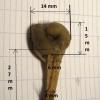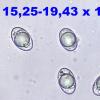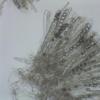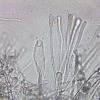
20-12-2025 23:08
Patrice TANCHAUDBonsoir, récolte sur sol sablonneux dans l'arri�

20-12-2025 15:47
Mirek GrycHi.These grew on pine wood that was heavily covere

18-12-2025 21:17
Pol DebaenstThe identification took me to Byssonectria deformi

15-12-2025 07:09
 Danny Newman
Danny Newman
indet. Rutstroemiaceae sp. on unk. fallen leavesMc

19-12-2025 10:10
Patrice TANCHAUDBonjour, récolte réalisée en milieu dunaire, a

18-12-2025 17:23
 Bruno Coué
Bruno Coué
Bonjour,je serais heureux d'avoir votre avis sur c

18-12-2025 18:07
Margot en Geert VullingsThese plumes were found on rotten wood.They strong

17-12-2025 18:35
 Michel Hairaud
Michel Hairaud
Bonjour à tous/Hi to everyone I am passing along
In the middle of an alder swamp forest, in Belgium, is a dike that the last six months has been inundated by the high water level.
Ascomata was found in November, at the base of a mossy, dead poplar (populus) seemingly growing on the bark.
Apothecium: 14 x 15 mm, saddle-shaped, selliform, grey-green, the brim is not attached to the stipe except one attachment of 0.5 mm wide;
Stalk: dirty yellow, 27 mm long, at the top 6 mm and 4 mm wide at the base, the whole length ribbed, the ribs run 2 mm further on the apothecium;
Spores: elliptical, 15,23-19,43 x 10,36-12,97 µm, Q = 1.53, 1 large drop and several small ones,
Asci: 194,53-261,53 x 16.77-22,17 µm; cylindrical, IKI-;
Paraphyse: septated, filiform, branched and 5 µm wide with up to 8 µm swollen top
Ectal exipulum: textura globulosa-subglobulosa length > 50 µm
Medular exipulum: textura intricate
Could this be Hevella lacunose var. sulcata or is it a H. lacunose that suffered from the wet weather and environmental conditions? Thanks for your help!
Greetings,
François Bartholomeeusen
Thanks for your good suggestion. I have read the description of H. phlebophora in Ascomycete.org and in Coolia 27 (1) but I still have my doubts. The ribs of the stalk continue on the bottom of the cap but they become very soon furrowed. My spore sizes are also slightly larger.
Greetings,
François





